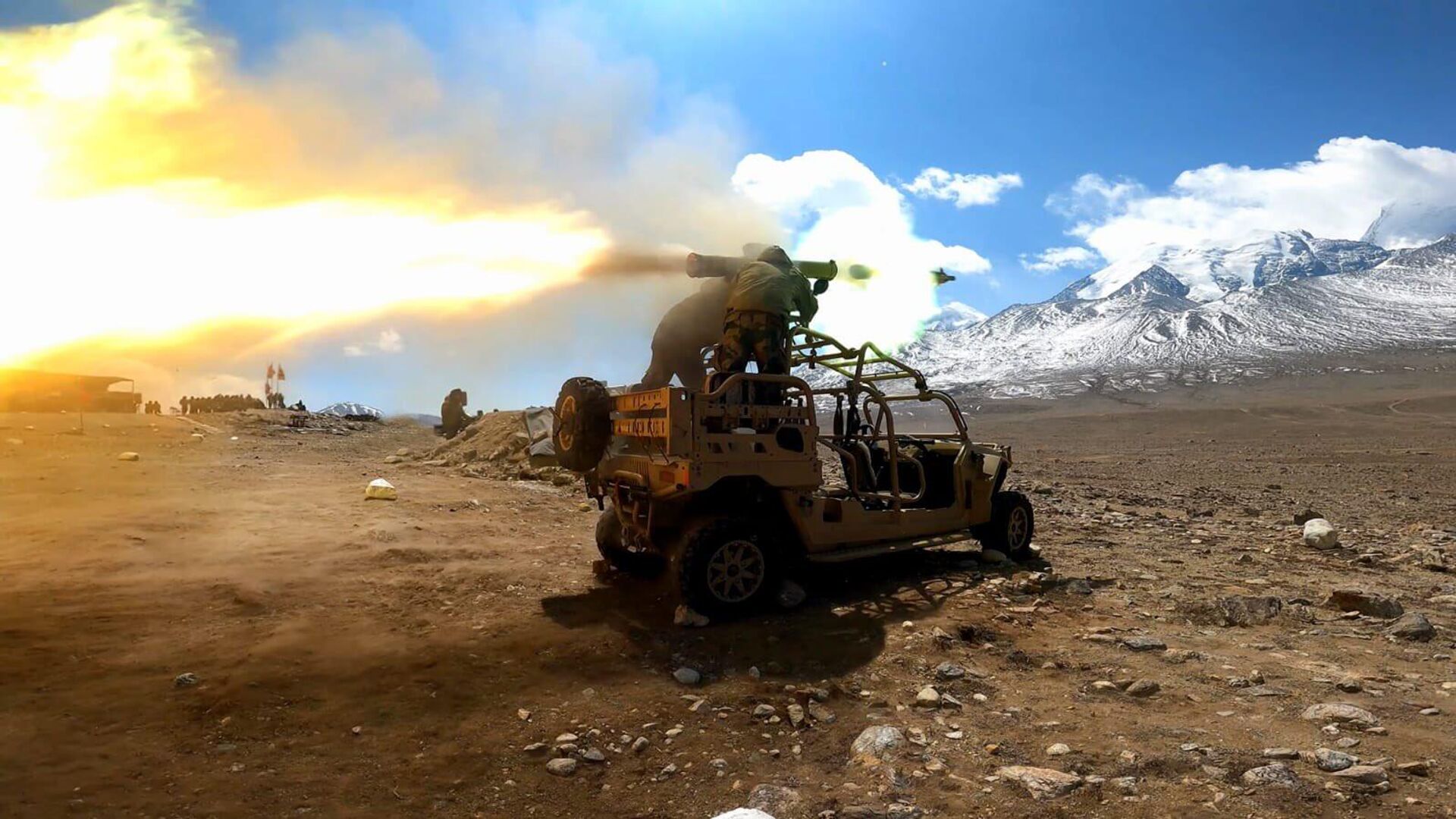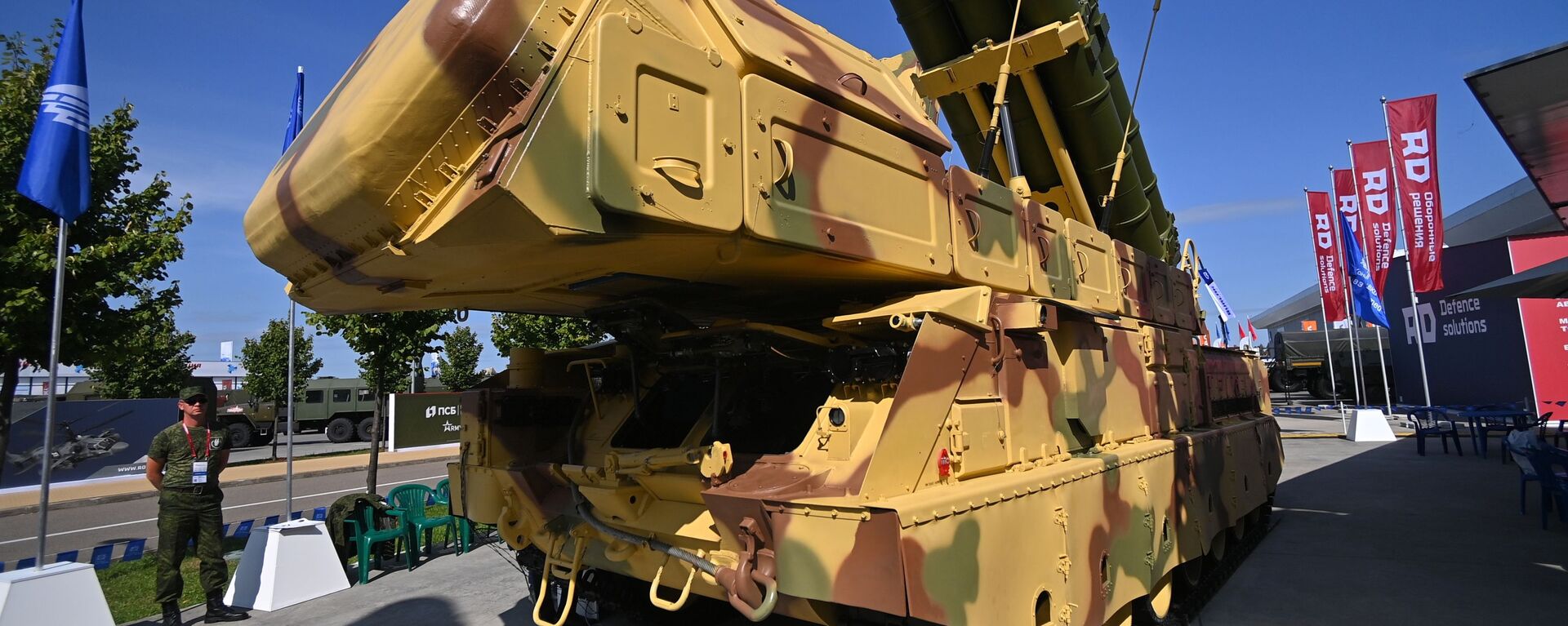https://sputniknews.in/20250308/indian-army-looking-to-induct-third-fourth-gen-atgms-military-source-8836859.html
Indian Army Looking to Induct Third, Fourth-Gen ATGMs: Military Source
Indian Army Looking to Induct Third, Fourth-Gen ATGMs: Military Source
Sputnik India
Taking lessons from the Russia-Ukraine war, where next-generation ATGMs have been used extensively, the Indian military is keen to upgrade its stockpile of... 08.03.2025, Sputnik India
2025-03-08T19:12+0530
2025-03-08T19:12+0530
2025-03-18T13:15+0530
defenсe news
india
pakistan
russia
people's liberation army (pla)
indian army
china
missiles
pakistan army
delhi
https://cdn1.img.sputniknews.in/img/07e8/04/0c/7112918_0:0:1600:900_1920x0_80_0_0_892d37a4b3058ffcb47167123678dd2d.jpg
The Indian Army is keen to induct third and fourth generation Anti-Tank Guided Missiles (ATGMs) as regional rivals, China and Pakistan, have already deployed missiles of same kind – HJ-12, Turkish-made OMTAS and Karaok – which are more accurate and can hit at farther ranges with greater penetration of armour, a Ministry of Defence (MoD) source told Sputnik India.The induction of next-generation ATGMs is not just a modernisation priority but a battlefield necessity. Today, the Indian Army's ATGM inventory is nearly 100% second-generation, which is obsolete by global standards, the official said on the condition of anonymity.In contrast, the rival countries have already fielded third and fourth-generation systems, offering fire-and-forget capability, top-attack profiles, and enhanced penetration against modern armour. These advanced ATGMs significantly increase the lethality and survivability of their forces, putting India's existing inventory at a disadvantage, the source added.Despite repeated efforts over the years, the indigenisation of third-generation ATGMs has faced continuous delays, with the promised systems yet to materialise in an operationally viable form. Notably, India has already test-fired the Amogha-III and Nag Mark 2, third-generation anti-tank missiles, in March 2023 and January 2025, respectively. While Bharat Dynamics Limited designed and developed the former, the latter is a product of the Defence Research and Development Organisation (DRDO). Interestingly, Amogha-III and Nag Mark 2 are fire-and-forget ATGMs and can operate in all weather conditions.As India does not currently have third—and fourth-generation ATGMs in its inventory, the induction of these weapons platforms becomes an urgent operational requirement that cannot be further delayed, Sputnik India has learnt.Any decisions regarding acquisition are made through a comprehensive assessment of effectiveness, sustainment, and long-term operational viability. As the process moves forward, the emphasis will be on securing proven, advanced ATGM systems that provide the necessary range, penetration, and survivability advantages required to maintain a decisive edge in modern warfare, the source concluded.For the unversed, the Indian Army uses a wide variety of Russian ATGMs right now. Among them, some of the prominent ones are 9M133 Kornet, 9K114 Shturm, and 9M113 Konkurs system. The 9M133 Kornet SACLOS (semi-automatic command to line of sight) weapon system and is primarily deployed against heavy armour by the Indian Army. Approximately 3000 9M133 Kornet missiles and their 250 launchers were in operation with the Indian Army till last year.On the other hand, the 9K114 Shturm, having the capability to annihilate moving targets within a range of 5 km, is equipped with a HEAT (High Explosive Anti-Tank) warhead. At present, the estimated figures of these systems in the Indian Army is believed to be around 800. Also, the Indian Army is in possession of a large pool of 9M113 Konkurs, which is a SACLOS wire-guided ATGM.
https://sputniknews.in/20250304/how-russias-viking-and-tor-m2-systems-could-bolster-indias-air-ambitions-8830181.html
india
pakistan
russia
china
delhi
new delhi
islamabad
beijing
Sputnik India
feedback.hindi@sputniknews.com
+74956456601
MIA „Rossiya Segodnya“
2025
Pawan Atri
https://cdn1.img.sputniknews.in/img/07e6/0c/13/139630_147:0:831:684_100x100_80_0_0_8fa2b25903e7787fe6a2698552c167df.png
Pawan Atri
https://cdn1.img.sputniknews.in/img/07e6/0c/13/139630_147:0:831:684_100x100_80_0_0_8fa2b25903e7787fe6a2698552c167df.png
News
en_IN
Sputnik India
feedback.hindi@sputniknews.com
+74956456601
MIA „Rossiya Segodnya“
Sputnik India
feedback.hindi@sputniknews.com
+74956456601
MIA „Rossiya Segodnya“
Pawan Atri
https://cdn1.img.sputniknews.in/img/07e6/0c/13/139630_147:0:831:684_100x100_80_0_0_8fa2b25903e7787fe6a2698552c167df.png
india, pakistan, russia, people's liberation army (pla), indian army, china, missiles, pakistan army, delhi, new delhi, islamabad, beijing
india, pakistan, russia, people's liberation army (pla), indian army, china, missiles, pakistan army, delhi, new delhi, islamabad, beijing
Indian Army Looking to Induct Third, Fourth-Gen ATGMs: Military Source
19:12 08.03.2025 (Updated: 13:15 18.03.2025) Taking lessons from the Russia-Ukraine war, where next-generation ATGMs have been used extensively, the Indian military is keen to upgrade its stockpile of this critical weapons platform.
The Indian Army is keen to induct third and fourth generation Anti-Tank Guided Missiles (ATGMs) as regional rivals, China and Pakistan, have already deployed missiles of same kind – HJ-12, Turkish-made OMTAS and Karaok – which are more accurate and can hit at farther ranges with greater penetration of armour, a Ministry of Defence (MoD) source told Sputnik India.
The induction of next-generation ATGMs is not just a modernisation priority but a battlefield necessity. Today, the Indian Army's ATGM inventory is nearly 100% second-generation, which is obsolete by global standards, the official
said on the condition of anonymity.
In contrast, the rival countries have already fielded third and fourth-generation systems, offering fire-and-forget capability, top-attack profiles, and enhanced penetration against modern armour. These advanced ATGMs significantly increase the lethality and survivability of their forces, putting India's existing inventory at a disadvantage, the source added.
"Compounding this challenge is the severe deficiency in ATGM stockpiles. Even within our current holdings, shortages stand at 40-50% for launchers and 75-85% for missiles. These figures will worsen as older systems are phased out, leaving critical gaps in our anti-armour capability. The necessity for modern, next-generation ATGMs is undeniable, as they are vital to countering future battlefield threats, including heavily protected armoured platforms equipped with active protection systems (APS)," the source highlighted.
Despite repeated efforts over the years, the indigenisation of third-generation ATGMs has faced continuous delays, with the promised systems yet to materialise in an operationally viable form.
Notably, India has already test-fired the Amogha-III and Nag Mark 2, third-generation anti-tank missiles, in March 2023 and January 2025, respectively. While Bharat Dynamics Limited designed and developed the former, the latter is a product of the Defence Research and Development Organisation (DRDO).
Interestingly, Amogha-III and Nag Mark 2 are fire-and-forget ATGMs and can operate in all weather conditions.
As India does not currently have third—and fourth-generation ATGMs in its inventory, the induction of these weapons platforms becomes an urgent operational requirement that cannot be further delayed, Sputnik India has learnt.
On being asked if Russian ATGMs like the Kornet were in the race for a contract from the Indian Army, the source replied: "The Indian Army evaluates all procurement options based on operational suitability, technological capability, and strategic considerations and its focus remains on ensuring that it acquires systems that meet India's battlefield requirements and doctrinal needs."
Any decisions regarding acquisition are made through a comprehensive assessment of effectiveness, sustainment, and long-term operational viability. As the process moves forward, the emphasis will be on securing proven, advanced ATGM systems
that provide the necessary range, penetration, and survivability advantages required to maintain a decisive edge in modern warfare, the source concluded.
For the unversed, the Indian Army uses a wide variety of Russian ATGMs right now. Among them, some of the prominent ones are 9M133 Kornet, 9K114 Shturm, and 9M113 Konkurs system.
The 9M133 Kornet SACLOS (semi-automatic command to line of sight) weapon system and is primarily deployed against heavy armour by the Indian Army. Approximately 3000 9M133 Kornet missiles and their 250 launchers were in operation with the Indian Army till last year.
On the other hand, the 9K114 Shturm, having the capability to annihilate moving targets within a range of 5 km, is equipped with a HEAT (High Explosive Anti-Tank) warhead. At present, the estimated figures of these systems in the Indian Army is believed to be around 800.
Also, the Indian Army is in possession of a large pool of 9M113 Konkurs, which is a SACLOS wire-guided ATGM.



